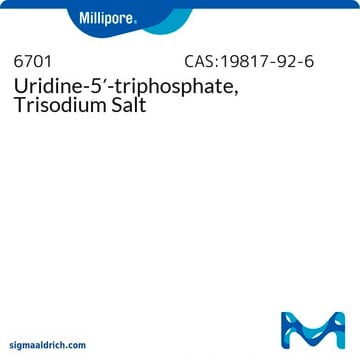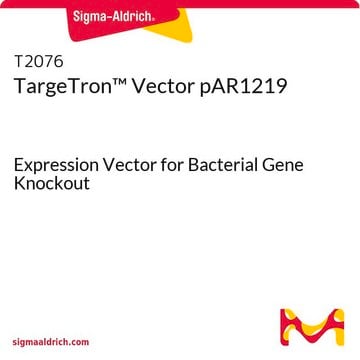U6875
Uridine 5′-triphosphate tris salt
Type VI, ≥90%
Synonyme(s) :
UTP
About This Item
Produits recommandés
Type
Type VI
Pureté
≥90%
Solubilité
H2O: soluble 50 mg/mL, clear, colorless
Conditions d'expédition
dry ice
Température de stockage
−20°C
Chaîne SMILES
NC(CO)(CO)CO.O[C@H]1[C@@H](O)[C@@H](O[C@@H]1COP(O)(=O)OP(O)(=O)OP(O)(O)=O)N2C=CC(=O)NC2=O
InChI
1S/C9H15N2O15P3.C4H11NO3/c12-5-1-2-11(9(15)10-5)8-7(14)6(13)4(24-8)3-23-28(19,20)26-29(21,22)25-27(16,17)18;5-4(1-6,2-7)3-8/h1-2,4,6-8,13-14H,3H2,(H,19,20)(H,21,22)(H,10,12,15)(H2,16,17,18);6-8H,1-3,5H2/t4-,6-,7-,8-;/m1./s1
Clé InChI
NHMNWWVJZZPKSL-IAIGYFSYSA-N
Vous recherchez des produits similaires ? Visite Guide de comparaison des produits
Catégories apparentées
Application
- to investigate its activation potential on the purinergic P2Y2 Receptor in THP1 monocytes
- as a component of non-radioactive nucleoside triphosphate solution used in in vitro RNA polymerase assay
- as a P2Y2 agonist in human embryonic kidney cells (HEK293T) in dynamic mass redistribution (DMR) assays
Actions biochimiques/physiologiques
Notes préparatoires
Code de la classe de stockage
11 - Combustible Solids
Classe de danger pour l'eau (WGK)
WGK 3
Point d'éclair (°F)
Not applicable
Point d'éclair (°C)
Not applicable
Équipement de protection individuelle
Eyeshields, Faceshields, Gloves, type P2 (EN 143) respirator cartridges
Certificats d'analyse (COA)
Recherchez un Certificats d'analyse (COA) en saisissant le numéro de lot du produit. Les numéros de lot figurent sur l'étiquette du produit après les mots "Lot" ou "Batch".
Déjà en possession de ce produit ?
Retrouvez la documentation relative aux produits que vous avez récemment achetés dans la Bibliothèque de documents.
Les clients ont également consulté
Notre équipe de scientifiques dispose d'une expérience dans tous les secteurs de la recherche, notamment en sciences de la vie, science des matériaux, synthèse chimique, chromatographie, analyse et dans de nombreux autres domaines..
Contacter notre Service technique











